
The Tower of Bablot...BABEL

Discovered 16 -17th September 06, around 12 midnight
1st Eden
.
Dalamatia City .
Northern Dilmun .
Eastern Dilmun .
Babel
. Susa
.
Van/Admason civilisation
Home
Latest Post
Dalamatia City
Radio
The Targum from the Beginnings
The Targum on the run thoughts fron various Forums research replies
TABLETS 1 2 3 4 5 6 7 8 9 10 11 12 13 14 15 16 17 18 19 20 21 22 23 24 25 26 27 28 29 30 31 32 33 34 35 36 37 38 39 40 41 42 43 44 45 46 47 48 49 50
51 52
53
54
Latest Post
Home
Dalamatia City
Radio
Google earth journey to the ancient places
The discovery of Babel /Dilmun was made on September 16th -17th at 12 midnight 06. The find was quite remarkable as what was discovered on that night was not one city but two cities as described in the Urantia Book, the two nodite cities. Susa and Babel/Dilmun, It was on that night of discovery before midnight that I was in heavy debate concerning the location of Atlantis.
The Urantia Book: The two Nodite Cities
line 96: The elaborate records left by the Sumerians describe the site of a remarkable settlement which was located on the Persian Gulf near the earlier city of Dilmun. The Egyptians called this city of ancient glory Dilmat, while the later Adamized Sumerians confused both the first and second Nodite cities with Dalamatia and called all three Dilmun. And already have archaeologists found these ancient Sumerian clay tablets which tell of this earthly paradise "where the Gods first blessed mankind with the example of civilized and cultured life." And these tablets, descriptive of Dilmun, the paradise of men and God, are now silently resting on the dusty shelves of many museums.
During the debate I opened a search for the ancient Andite signs in Africa through rock art, examining the round headed man as I thought sounded similar to the description of the Andites of old. In formulating my response I then came across a fragment on the internet concerning Tipura found in the Hindu religion, the Mahabharata. I found mentioned a great city that burned to the ground and and sunk in the sea on a latitude of 24 - 28. I immediately opened worldwind and considered Dalamatia City and search for it in around Bahrain. Whilst scanning the area I couldn't see much and so it occurred to me to scan the Northern Persian Gulf which I proceeded to do. I viewed the area and noticed some unusual anomalies that seemed to fit the location of what I thought was Dalamatia city but in actual fact was what I named Tipura/Dilmun at the time was actually 1stSusa. Here is the following thread that lead me to the discovery of 1st Susa followed soon after the discovery of Babel/Dilmun.
The location of the circular foundation of the first and second towers of Babel
The thread that led me to the discovery of the 2 Nodite cities
this was on the night of September 16-17 06 -----------------------------------------------------
Here some pictures on Lixus in Morocco, the outpost of the very early Andite influence. It could give clues to the Early Andite expansion in Morocco. The stone work seems to be similar to the stone work of the Andites. Even though the Romans reshaped the early ruins for there own purposes.
Know this culture also spread into Europe to Spain, Switzerland and Italy and is evident in the region of the circles.
These are the clues.
The first King of Atlantis was Urania, Sounds very close the Uran, Urantia, Ur. Again from the east moving west. Note the religion of the circle spread throughout all of Europe, You could say it was revival was akin to sun and moon worship.
http://www.atlantisquest.com/Archeology.html

Here is another view of the ancient Andite Blocks like in Baalbek
The Cyclopean Wall at Lixus on the River Lucus, near Larache in Spanish Morocco.
http://www.goldenageproject.org.uk/129cyclopean.html
and another mark of the Andites.
Here is a little something stumbled across, I wonder if its a clue to Dalamantia looking at the latitude (this was the point realisation to look for Dalamatia)
- INDIA’S ATLANTIS:
In Hindu legends an island of gods was destroyed during a war between the gods and the Asuras (giant people). Which is very similar to the greek myth of the gods Vs the Titans.
Vishnu Purana (2000 B.C.), a sanskrit text, speaks of Atala, the "White Island," which speaks of its geographically location, which when translated is roughly 24-28 degrees North latitude. There is no longitude translation.
Mahabharata tells of a horrendous war that sunk Atala. It is also called the White Island in this text. It describes it as an "island of great splendour" in the western ocean. It is also describes Tipura, a circular shaped capital city, which was destroyed by being “burnt until it sank into the ocean”.
The Latitude seems to fall in the Bahrain area.
Another piece of the puzzle and the Persian Gulf is the Sea to the West.
I believe story of Tipura contains distant reflections of Van mentioned in the Urantia Book. His symbol from what I can ascertain was the 3 coplanar circles which can seen in formation in the anomalies at his headquarters. These anomalies can also be seen on the top of the Acropolis Hill submerged in First Eden of Cyprus. I believe the 3 coplanar circles evolved into the 3 concentric circles and are connected to each other.
Here is a search of Van in the Urantia Book and the Vanite Culture. The Vanite Culture was before the Adamson Culture. The Vanite and the Admason culture had its headquarters in North Eastern Iran as seen here.
The origins of Babel is ancient and it relates to the Nodite culture that has perpetuated throughout the eons of time since the fall of Dalamatia City. Babel was originally part of the Nodite culture but over time the Adamite and the Nodite cultures admixed to create the Andite culture that lived in the North Eastern Persian Gulf when the sea Levels were lower. This culture existed for thousands of years but was soon destroyed, I estimate around 8000BC perhaps further back. Refugees of the destruction of this Andite Capital was sent abroad to Bahrain which adopted the Dilmunite culture and in name. Other Andites also migrated to in Egypt during the flood periods, the evidence of the Andites can be seen in the pyramids and all over the world spreading civilisation. The symbol of the Nodite/Andite/Admaite cultureis the triangle with the single circle within.
The main feature of Babel in Dilmun are the foundations of the circular foundations which can be seen from space. The circular structure appears to set within a double triangle. This symbol has perpetuated throughout the eons of time that made it way through the pyramids on down to Jesus' family tomb and beyond. This same symbol can seen on Mars near the face in Cydonia.
The 2 Nodite Cities are 1Susa and Babel/Dilmun both received and adopted myths of the true City of the Gods Dalamatia City which is reflected in each culture that the Andite people helped to build. The Atlantis myth is the result of the Andite migrations into Egypt.
12,000 years ago a second attempt was made to erect another tower of Babel on the very same foundations as the first Babel built by the pure Nodites many thousands of years ago.
Here is an extract out of the Urantia Book.About twelve thousand years ago a second attempt to erect the tower of Babel was made. The mixed races of the Andites (Nodites and Adamites) undertook to raise a new temple on the ruins of the first structure, but there was not sufficient support for the enterprise; it fell of its own pretentious weight. This region was long known as the land of Babel.
However there was a third attempt to build a third tower of Babel as we can see in the following Urantia Book description
These conquerors of Mesopotamia carried in their ranks many of the better Andite strains of the mixed northern races of Turkestan, including some of the Adamson stock. These less advanced but more vigorous tribes from the north quickly and willingly assimilated the residue of the civilization of Mesopotamia and presently developed into those mixed peoples found in the Euphrates valley at the beginning of historic annals. They quickly revived many phases of the passing civilization of Mesopotamia, adopting the arts of the valley tribes and much of the culture of the Sumerians. They even sought to build a third tower of Babel and later adopted the term as their national name.
This may account for the supposed Babel structures in current Mesopotamia
http://www.gutenberg.org/files/18031/18031-h/18031-h.htm#Tower_of_Babel
and
http://www.sacred-texts.com/bib/ebd/ebd041.htm
I believe the third tower of Babel was located in about 7 miles south-west of Hillah,
However, I believe the first and second Tower of Babel lays submerged of the North Eastern Coast of Iran and is the source root of the Legend of Atlantis.
In the following are 3d images of the worldwind images of Babel.
New Babel Gallery
Tower of Babel within the city of Dilmun
A view of
Dilmun and Babel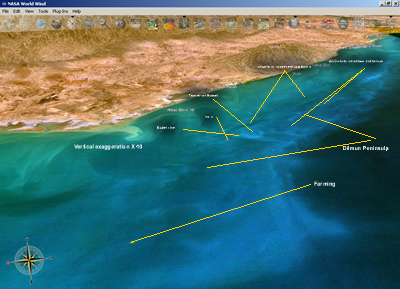 |
Possible
walled fortifications to prevent flooding of the rising sea levels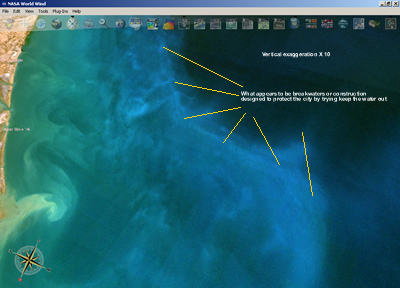 |
The walls of
Dilmun |
Babel looking
from the South and the depiction of the circular foundations and the walls of Babel  |
A side view
of Babel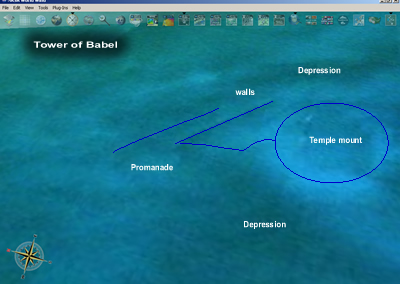 |
A depiction
of the tower of Babel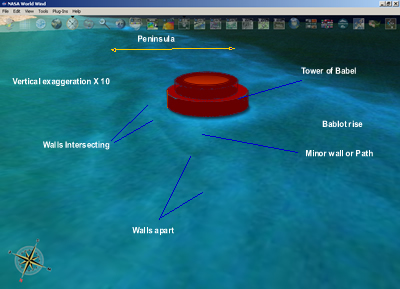 |
Another view
of Babel as seen.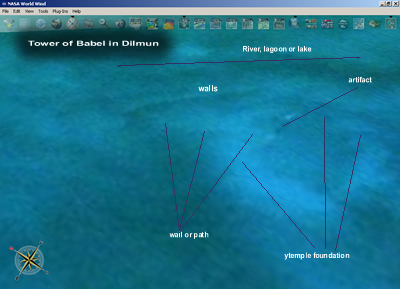 |
The Isthmus
of Dilmun which Jutted into the sea as described by Enki.
The Isthmus was surrounded by lakes, lagoons, the sea and raised canals
and walls. Similar to the Plato description of Atlantis being on an
isthmus.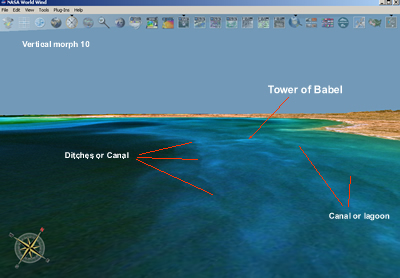 |
The Breach of the Northern walls where the sea broke the walls and flooded the area.  |
The Lands of
Bablot or Babel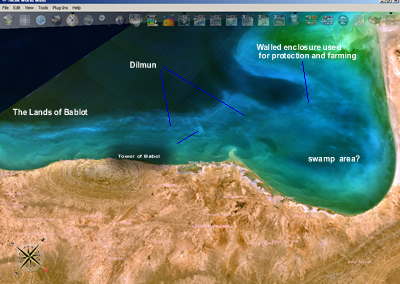 |
|
Here is a Google Earth
file with Place marks |
|
These raised canal features appears to be identical to the canals as described in Plato's Atlantis story.
|
|
Search on entire archive
File name (modification date), and list of matched lines (preceded by line
numbers)
CONTENTS
OF THE BOOK, Aug 31 2001
PAPER 77 - THE
MIDWAY CREATURES, Oct 19 2000
PAPER 78 - THE
VIOLET RACE AFTER THE DAYS OF ADAM, Oct 19 2000
"babel":Accumulated thoughts and ideas on Babel
http://www.urantia.org/cgi-bin/webglimpse/webglimpse/usr/local/www/data/papers?query=bablot&submit=Submit
3. THE TOWER OF BABEL
After the submergence of Dalamatia the Nodites moved north and east, presently founding the new city of Dilmun as their racial and cultural headquarters. And about fifty thousand years after the death of Nod, when the offspring of the Prince's staff had become too numerous to find subsistence in the lands immediately surrounding their new city of Dilmun, and after they had reached out to intermarry with the Andonite and Sangik tribes adjoining their borders, it occurred to their leaders that something should be done to preserve their racial unity. Accordingly a council of the tribes was called, and after much deliberation the plan of Bablot, a descendant of Nod, was indorsed.
Bablot proposed to erect a pretentious temple of racial glorification at the center of their then occupied territory. This temple was to have a tower the like of which the world had never seen. It was to be a monumental memorial to their passing greatness. .
There were many who wished to have this monument erected in Dilmun, but others contended that such a great structure should be placed a safe distance from the dangers of the sea, remembering the traditions of the engulfment of their first capital, Dalamatia.
Bablot planned that the new buildings should become the nucleus of the future center of the Nodite culture and civilization. His counsel finally prevailed, and construction was started in accordance with his plans. The new city was to be named Bablot after the architect and builder of the tower. This location later became known as Bablod and eventually as Babel.
But the Nodites were still somewhat divided in sentiment as to the plans and purposes of this undertaking. Neither were their leaders altogether agreed concerning either construction plans or usage of the buildings after they should be completed. After four and one-half years of work a great dispute arose about the object and motive for the erection of the tower. The contentions became so bitter that all work stopped. The food carriers spread the news of the dissension, and large numbers of the tribes began to forgather at the building site. Three differing views were propounded as to the purpose of building the tower.
1. The largest group, almost one half, desired to see the tower built as a memorial of Nodite history and racial superiority. They thought it ought to be a great and imposing structure which would challenge the admiration of all future generations.
2. The next largest faction wanted the tower designed to commemorate the Dilmun culture. They foresaw that Bablot would become a great center of commerce, art, and manufacture.
Page 859 3. The smallest and minority contingent held that the erection of the tower presented an opportunity for making atonement for the folly of their progenitors in participating in the Caligastia rebellion. They maintained that the tower should be devoted to the worship of the Father of all, that the whole purpose of the new city should be to take the place of Dalamatia--to function as the cultural and religious center for the surrounding barbarians.
The religious group were promptly voted down. The majority rejected the teaching that their ancestors had been guilty of rebellion; they resented such a racial stigma. Having disposed of one of the three angles to the dispute and failing to settle the other two by debate, they fell to fighting. The religionists, the noncombatants, fled to their homes in the south, while their fellows fought until well-nigh obliterated.
About twelve thousand years ago a second attempt to erect the tower of Babel was made. The mixed races of the Andites (Nodites and Adamites) undertook to raise a new temple on the ruins of the first structure, but there was not sufficient support for the enterprise; it fell of its own pretentious weight. This region was long known as the land of Babel.
I felt that was interesting and there is some good clues.
Like the religious group who fled to the South to there homes.
This tells me that Dilmun must of had land to the south adjoining
a coastline. It was a North/South city with the sea to the east.
Its interesting that a 2nd attempt to erect Babel was made on the
first foundations. Is that to mean that the ancient land Dilmun
was above water?? 12,000 years ago?
Note that 12,000 years ago the sea level was lower and maybe the
ancient lands of Dilmun was above water. Dilmun must of been on a
higher level than Dalamatia.
Here is a image of what I think is the foundations of Bablot/Babel
and including clues of the general area. Dilmun must been built in
a North South fashion and was next to a sea.
The North-South Peninsula on which Dilmun was
built and thrived.
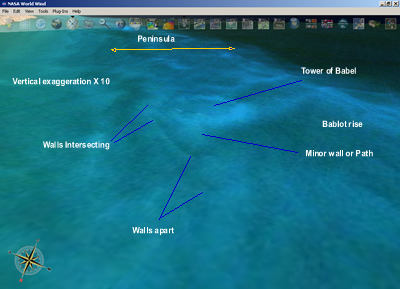
I also feel that the destruction of Dilmun is reflected in Isaiah

In the following are some posts at the time of discovery.
It must of been on the Eastern Persian Gulf which is now
submerged.
http://www.dalamatiacity.com/dilmun5.jpg
Im still thinking about it more
So it seems to me that 1st Dilmun
was above water 12,000 years ago and was occupied. Considering the present
ruins isn't that far under the current sea level. This is around the times
when the Harrappan coastline cities where lost due to increasing sea levels.
Dilmun from what I can see was a huge cultural and commercial center.
regards
sevens
[ 01-10-2007, 09:01 PM: Message edited by: sevens ]
Here is something that seems to indicate an earlier position of Dilmun near the North Eastern cost of the Persian Gulf
Hi
Currently, I'm researching the sea level at around 12,000 years ago to make
sure Dilmun was above water.
Its interesting that the timeline and the sea levels 12,000 ago seems to be
right
Sea levels 12,000 years ago
World coasts have seen sea-level variation of approximately 100 metres within the past 11,500 years through melting of the ice caps. When the ice caps melt the sea level rises globally (eustatically). The relative sea-level at any location is measured proportionate to the nearby land, which is itself subject to tectonic movement both up and down.
and
Wikipedia Deluge
In the relatively recent geological past, several great floods are widely suspected to have occurred, with varying amounts of supporting evidence, usually as a result of the last Ice Age ending.
At the most recent glacial maximum, so much of the planet's water was locked up in the vast ice-sheets that formed ice domes kilometers thick, that the sea level dropped by about 120 to 130 meters. As the sheets melted starting around 18,000 years ago sea levels rose. Most of the glacial melt had occurred by around 8,000 years ago, but the changes have not been as regular as a constant drip at the edges of the world's glaciers might suggest.
So it seems to me that 1st Dilmun was above water 12,000 years ago and was occupied. Considering the present ruins isn't that far under the current sea level. This is around the times when the Harrappan coastline cities where lost due to increasing sea levels.
Dilmun from what I can see was a huge cultural and commercial center.
Also
Here is something that seems to indicate an earlier position of Dilmun near the North Eastern coast of the Persian Gulf
Just as cuneiform sources situate Dilmun and Magan on the western shore of the Persian Gulf, recent scholarship has favored locating the region of Mishime (Miæima), attested in pre-Sargonic and Old Akkadian sources, or P/Bashime, as it was generally known in Old Akkadian, Ur III and Old Babylonian texts, along the northeastern coast of the Gulf, roughly between Bushehr and the Shatt al-Arab (ˆatÂt al-¿Arab) estuary (Steinkeller, 1982, pp. 240-2) or possibly more precisely in the area of Bandar-e Deylam (e.g. Vallat, 1993, p. CXXVI). Mishime is first attested during the reign of Eannatum of Lagash (ca. r. 2450-25 BCE) who, in addition to conquering Elam, claims to have raided and destroyed Mishime (Sollberger and Kupper, 1971, pp. 58-59; Selz, 1991, pp. 34,
and some aspects of Dilmun found in tablets
web page
"...Bit-Iakin on the shore of the Bitter Sea, as far as Dilmun's border- all these I brought under one rule..." (p. 335. Potts)
"...Uperi, king of Dilmun, whose camp is situated, like a fish, thirty beru (double-hours) away in the midst of the sea of the rising sun..." (p. 334. Potts)
Hymns to Enki, who resided at Eridu, stated that the city was at the edge of _the sea_ and the shadow cast by its fruit trees panted by his shrine fell upon the nearby snake marsh.
The Mesopotamians called the salt-marshes marattu meaning "bitter" (marah = bitter), perhaps the Hawr Hammar preserves in Arabic the earlier Mesopotamian marattu ?
(Seems to match Dilmun submerged Northeastern Persian Gulf.)
I wonder what scholarly
information leads them to Dilmun on the North Eastern in section of the gulf?
regards
sevens
Anyway, what I think is a good way to estimate the final demise of Dilmun is by following the second last dispersal of the Andite peoples at around 9000BC from Mesopotamia. It was when the Andites where entering Malta and Cyprus. I suggest that these Andites where refugees from the city of Dilmun and Mesopotamian coastline about 9000BC and have carried the circle emblem in there religion as seen in very ancient ruins in Spain, England, Malta, Cyprus, and other parts of Europe. I feel this circle sign of Bablot perpetuated through those very ancient Andites reminiscent of Dilmun there paradisiacal vista of glory.
A little speculation
However around 6000BC was there last dispersal because of Noah's flood.
I find it interesting that Bablot or Babel is still kept in the legends of religion even from 12,000 years ago. I wonder if there are some elements of Plato in here and whether the record of the Egyptian of Atlantis is really about Dilmun knowing that Egypt would of received these Andite refugees from Dilmun.. Many people seem to suggest Atlantis went down 10000 years which seems to match the Dilmun and Bablot destruction and other areas of the Persian Gulf. Remembering that Dilmun was considered a paradise of Glory and connected to Dalamatia the original home of the Gods. The legend of Dalamatia transferred to the Dilmun after its destruction and then upon destruction of Dilmun itself I would say around 9000BC. The refugees of the destruction brought there legends with them including Dilmun.
The Egyptians recorded this information and was eventually transferred to Plato and then becomes Atlantis if we are looking around 11,000 years ago.
Dilmun, The Harrappan coastal cities and other commercial centers were destroyed in that time. However the only common thing is the circle shape In Dilmun you have the circular temple/tower, the circular temple in Dalamatia and circles mentioned in Plato and the fact that all three places were considered the home of the Gods. All common with Dilmun, Dalamatia, Eden and Atlantis, they were all considered home of the Gods However the Sumerians got Dilmun, Dalamatia and Eden all confused and so as you would expect all the stories of the home fo the gods have cross pollination of descriptions that intersect each other but does need unraveling and better understanding.
If we could prove that Dalamatia and Dilmun the east of it and prove through expeditions these places do exist and we can find evidence of mans existence there it could mean many things. For example of we could prove the date of Dilmun through studies of tower of Babel and the walls to the North around that timeline then we could prove that a renown home of the Gods existed and was submerged this would Parallel the Harrappan coastal city submergence.
Also the Urantia Book gives us clues to stone tablets lay of mealtime prayers which are given in the Urantia Book. If we can find those tablets with the inscriptions then we can work out the language which should be a peculiar writing system perhaps similar to an Aryan tongue sound.
We could find a match to there alphabet of 12000 years ago of the Dilmunites or the Babelots. Remember Dilmun was foreseen as a great commercial center which it was. But that world was wiped out and all other commercial cultures as the cities were destroyed by the sea. Only there legends exist and all mixed in together with all pieces of the real truth.
Just thinking about the location of those tablets with the mealtime prayers.
I feel the tablets could be in Dalamatia being the original home of the Gods and it was destroyed suddenly. So perhaps there lays intact tablets in the rubble.
However in the Urantia Book it tells us that the tablets are off the coast of Iran which leads me to believe that the most important place in Dilmun where the tablets may exist is near the tower of Babel. Perhaps! Remembering that the tower was last worked on 12,000 years ago. At the height of another glory time.
Just imagine doing an expedition over these places just following the clues given in the Urantia Book. Going there in an boat discovering these places, finding the tablets as perceived beforehand through the Urantia book Deciphering the language of the prayers which leads to more discoveries of there libraries or something. If they existed and continue uncovering this massive city that existed for 150,000 years.
Well that would be beautiful and would be possible even in light of the situation. I feel the information behind this would be enough to change the gravity of truth.
All the best
sevensFurther perspective of Babel
When you look at the tower of Babel from an exaggerated point of view of 10 in the vertical you find outstanding things such as Two walls that seem to be joined near the temple, then when you trek along the walls from the temple the walls seem to separate into 2 walls thus forming a point from the circular tower at its end. The tower of Babel seems to be on a slight rise further down the rise from the wall you seem to have a depression that appears to go further south for some distance. In my mind it is quite possible that Dilmun was situated on a peninsula or an isthmus backed by Lagoons and freshwater perhaps. It may of been a natural harbor for its commercial center.
Regarding the location of the tower of Babel. It is mentioned in the Urantia Book that the they were given advise to build the temple away from the sea in light of the Dalamatia experience. Looks like that advise wasn't heeded as the construction was built on sand and could not take the weight of the circular tower that was built on the possible isthmus looking at it from a exaggerated point of view. I feel Dilmun was built on an isthmus close to the Sea and it was backed by lagoons and quays which could of been freshwater running down from the backing hills. A description of Dilmun describes mentions the bitter water turning into the sweet waters with also mention of lagoons and bays and quays thus confirming that Dilmun was near freshwater close to the bitter water, the sea. In my mind it tends to full fill all the descriptions of the ancient Sumerians regarding Dilmun.
The following image in exaggerated form seem to show that it was quite possible for Dilmun to be surrounded by Lagoons, Bays and Quays. All consider that much erosion would of occurred during the inundation to this time.
In the following image is an interesting one. Its is exaggerated by 10 and it seems to depict a sea barrier all along the coast in an vain attempt to protect there city. Perhaps the Dilmunites seeing that there homeland was threatened decided to build a sea barrier to protect there homes or maybe a better explanation is that the barriers are old sand dunes from the existing coastline at that time.
I thought the following was an interesting link about the Persian Gulf. Remember the attempted construction of the The Tower of Babel and then the second last wave of the Andites to the Med and beyond as mentioned in the Urantia Book.
Here is a link I found in the Wikipedia which basically confirms that the Persian gulf was most likely a huge freshwater swamp area with a large river running close to Eastern Persian Gulf.
extract
The lower Tigris-Euphrates Valley, reflooding the Persian Gulf (12,000 years ago)
This is type 1. When sea levels were low, the combined Tigris-Euphrates river flowed through a wide flat marshy landscape. The Persian Gulf today has an average depth of only 35 m.[2] During the most recent glaciation, which ended 12,000 years ago, worldwide sea levels dropped 120 to 130 m, leaving the bed of the Persian Gulf well above sea level during the glacial maximum. It had to have been a swampy freshwater floodplain, where water was retained in all the hollows. High in the Taurus Mountains glaciation will have been extensive.
The drainage of the combined glacial era Tigris-Euphrates made its way down the marshes of this proto-Shatt-al-Arab to the Strait of Hormuz into the Arabian Sea. Reports of the exploration ship "Meteor" have confirmed that the Gulf was an entirely dry basin about 15,000 BC. Close to the steeper Iranian side a deep channel apparently marks the course of the ancient extended Shatt al-Arab. A continuous shallow shelf across the top (north) of the Gulf and down the west side (at 20 m) suggests that this section was the last to be inundated. At the Straits of Hormuz the bathymetric profile indicates a division into two main channels which continue across the Bieban Shelf before dropping to a depth of c 400 m in the Gulf of Oman; the deeper parts of these channels may be due to delta deposits at the edge of the deep ocean collapsing in a succession of big underwater landslides, causing underwater erosion by the resulting turbidity currents.
There is a theory that there was also a Black-Sea-type sill collapse at the Strait of Hormuz at the outlet of the Persian Gulf, so converting this case into type 3.
In a 1981 Journal of Cuneiform Studies article, "The Tangible Evidence for the Earliest Dilmun", Theresa Howard-Carter espoused her theory identifying Dilmun with Qurna, an island at the Strait of Hormuz. Her scenario put the original mouths of the Tigris-Euphrates rivers, which she thought should be the site of the primeval Dilmun, at or even beyond the Straits of Hormuz. Mainstream archaeologists have avoided mentioning her article, for fear of its apparent catastrophism, an awkward subject in geology.[3] Theresa Howard-Carter also wrote: "It is more likely that the original Gulf inhabitants lived along the banks of the lower or extended Shatt al-Arab, ranging some 800 km across the dry Gulf bed. We can thus postulate that the pre-Sumerian cultures had more than ample time to be born and flourish in a riverine setting, encouraged by the agricultural potential and the blessings of a temperate climate. The fact that the body of proof for the existence of these societies must now lie at the bottom of the Gulf furnishes at least a temporary excuse for the archaeologist's failure to produce evidence for their material culture."
In our time, mangrove edge habitat and coral reefs characterize the Persian Gulf. Mangroves recolonize easily from established mangrove fringe colonies elsewhere in the Arabian Sea. Artificial reefs are being established today along the coast of Iran. But if the Persian Gulf filled so recently, then how have the reefs re-established? The present-day natural reef developments in the Persian Gulf, corals grow on hardground substrates but have not yet formed the massive calcium carbonate structures familiar from, say, Australia's Great Barrier Reef.[4]
The article Dive conditions described by Eric Bjornstrom found in 1999 in Dubai coral-encrusted sand barrier islands situated 32 km off the coast of the Saudi city of Jubail.[5] There lies a chain of five coral cays, barely above the tide. They appear to be formations called diapirs in which a mobile core containing minerals of low density such as salt, deforms under pressure. The core pushes upwards, deforming overlying rock to form a dome. An ancient diapir at Enorama formed an island in shallow seas, buoyed up by salt. There are similar examples today in the Persian Gulf.
So early Dilmun and Dalamatia was in a freshwater riverine setting enough to sail back and forth on. at around 15000BC, By 12,000 years ago the attempted tower construction for the second time failed and you hear of there dispersion about 2000 years later due to floods and the no doubt encroachment of the sea.
Here is a thread on the road to Dilmun in the journey to the ancient places